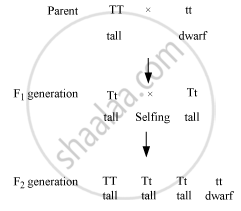Advertisements
Advertisements
प्रश्न
If we pure-bred tall (dominant) pea plant with pure-bred dwarf (recessive) pea plant we will get pea plants of F1 generation. If we now self-cross the pea plant of F1 generation, then we obtain pea plants of F2 generation.
(a) What do the plants of F2 generation look like?
(b) State the ratio of tall plants to dwarf plants in F2 generation.
(c) State the type of plants not found in F1 generation but appeared in F2 generation, mentioning the reason for the same.
उत्तर
When a pure breeding tall pea plant is crossed with a pure breeding dwarf pea plant
(a) All the plants in the F1 generation appear tall.
(b) The ratio of tall pea plant to dwarf pea plants is 3 (tall) : 1 (dwarf).
(c) The dwarf plant does not appear in the F1 generation but appears in the F2 generation because the progeny produced in the F1generation were heterozygous (Tt). Hence, when they were selfed for obtaining the F2 generation, dwarf plants were also formed in the progeny. The cross involved in as follows

संबंधित प्रश्न
Mendel crossed tall pea plants with dwarf pea plants in his experiment. Write his observations giving reason on the F1 and F2 generations.
List any two contrasting characters other than roundness of pea plants that Mendel used in his experiments with pea plants.
A study found that children with light-coloured eyes are likely to have parents with light-coloured eyes. On this basis, can we say anything about whether the light eye colour trait is dominant or recessive? Why or why not?
In the F2 generation of a cross, progeny having different traits are produced in the ratio 3 : 1. State whether it is a monohybrid cross or a dihybrid cross? Give one example of such a cross.
Gregor Mendel's first law of genetics states "Of a pair of contrasted characters, only one can be represented in a gamete by its internal 'factor' State where these factors are found in gametes.
A cross between a tall plant (TT) and short plant (tt) resulted in progeny that were all tall plants because :
(a) tallness is the dominant trait
(b) shortness is the dominant trait
(c) tallness is the recessive trait
(d) height of plant is not governed by gene T or t
A red-haired woman marries a brown-haired man, and all the children are brown haired. Explain this genetically.
One of the following traits cannot be inherited. This one is :
(a) colour of eyes
(b) colour of skin
(c) size of body
(d) nature of hair
Which of the following statement is incorrect?
Rewrite the correct form of the statement by changing the first or last word only:
The inheritable feature of an organism is termed as heredity.
